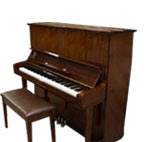Igor Stravinsky, born June 17, 1882, is a highly celebrated composer and conductor. One of his most famous works, Rite of Spring, premiered 100 years ago and caused quite a riot — literally! On this anniversary of a performance that made history, we would like to honor Stravinsky during his birthday month.
Igor Stravinsky was one of music’s truly epochal innovators; no other composer of the twentieth century exerted such a pervasive influence or dominated his art in the way that Stravinsky did during his seven-decade musical career. Aside from purely technical considerations such as rhythm and harmony, the most important hallmark of Stravinsky’s style is, indeed, its changing face. Emerging from the spirit of late Russian nationalism and ending his career with a thorny, individual language steeped in twelve-tone principles, Stravinsky assumed a number of aesthetic guises throughout the course of his development while always retaining a distinctive, essential identity.

Although he was the son of one of the Mariinsky Theater’s principal basses and a talented amateur pianist, Stravinsky had no more musical training than that of any other Russian upper-class child. He entered law school, but also began private composition and orchestration studies with Nicolai Rimsky-Korsakov. By 1909, the orchestral works Scherzo fantastique and Fireworks had impressed Sergei Diaghilev enough for him to ask Stravinsky to orchestrate, and subsequently compose, ballets for his company. Stravinsky’s triad of early ballets — The Firebird (1909-1910), Petrushka (1910-1911), and most importantly, The Rite of Spring (1911-1913) — did more to establish his reputation than any of his other works; indeed, the riot which followed the premiere of The Rite is one of the most notorious events in music history.
Stravinsky and his family spent the war years in Switzerland, returning to France in 1920. His jazz-inflected essays of the 1910s and 1920s — notably, Ragtime (1918) and The Soldier’s Tale (1918) — gave way to one of the composer’s most influential aesthetic turns. The neo-Classical tautness of works as diverse as the ballet Pulcinella (1919-1920), the Symphony of Psalms (1930) and, decades later, the opera The Rake’s Progress (1948-1951) made a widespread impact and had an especial influence upon the fledgling school of American composers that looked to Stravinsky as its primary model. He had begun touring as a conductor and pianist, generally performing his own works. In the 1930s, he toured the Americas and wrote several pieces fulfilling American commissions, including the Concerto in E flat, “Dumbarton Oaks.”
After the deaths of his daughter, his wife, and his mother within a period of less than a year, Stravinsky emmigrated to America, settling in California with his second wife in 1940. His works between 1940 and 1950 show a mixture of styles, but still seem centered on Russian or French traditions. Stravinsky’s cultural perspective was changed after Robert Craft became his musical assistant, handling rehearsals for Stravinsky, traveling with him, and later, co-authoring his memoirs. Craft is credited with helpin Stravinsky accept 12-tone composition as one of the tools of his trade. Characteristically, though, he made novel use of such principles in his own music, producing works in a highly original vein: Movements (1958-1959) for piano and orchestra, Variations: Aldous Huxley in Memoriam (1963), and the Requiem Canticles (1965-1966) are among the most striking. Craft prepared the musicians for the exemplary series of Columbia Records LPs Stravinsky conducted through the stereo era, covering virtually all his significant works. Despite declining health in his last years, Stravinsky continued to compose until just before his death in April 1971.








Leave a reply